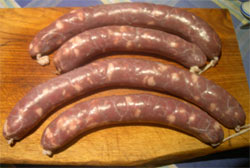The Salami Project: part two
Posted by Fiona Nevile in Curing and Smoking | 5 comments I wondered why all the recipes that I found for salami didn’t mention pork hock. They all seemed to go for shoulder.
I wondered why all the recipes that I found for salami didn’t mention pork hock. They all seemed to go for shoulder.
Three hours later, I know why.
It took me a good hour to remove the gristle from two hocks. At least I thought I’d removed the gristle until Eva, dug in her trotters and only let a thread width shred of mince escape from her furred up disks.
Eva has replaced Mincy who just pulverised meat. Great if you are feeding an invalid or a toothless dog but a no no if you want proper minced meat. The extended mincing process tested the patience of the dogs this evening, who assumed that I was taking my time to prepare a pork supper for them.
885g of hock turned into 625g of lean salami pork with a few gristly bits. They dogs were delighted with their supper – braised for them as I battled to keep Eva’s orifices clean and at her mince producing best. In fact I have enough left over gristly bits to feed the dogs (topping on their ‘all on one’ biscuit) for a week. I’m going to buy shoulder of pork next time. The dogs disagree.
I am trying two salami recipes. The HFW one from The River Cottage Cookbook and a rather elegant one from an IT consultant in Hackney I’ve adapted the recipes to match the Cottage Smallholder purse so instead of the Cabernet Sauvignon and Rioja of the Hackney one we are experimenting with Viñapeña (quite gluggable and in a handy 24 serving sized box from Netto – £9.99 for 3 litres) and the pork hocks.
The reason for selecting these two recipes is that one adds acidopholus (good bacteria) and the latter does not.
It turns out that Fred is concerned about adding bacteria. Apparently when The Chicken Lady went into Fred’s this morning, he mooted his apprehension.
“It is fine,” she replied, “Danny has agreed to taste it first and if he’s alive in a couple of days time we can tuck in.”
Most salami recipes add acidophulous so on that front I am calm.
When I went to collect the salami skins (natural hog casings) this afternoon, Fred gave me a quick sausage making lesson. These casing are extremely long and flexible. He held one up it looked as thin as a piece of string. Fred’s sharp look made me quickly put aside all thoughts of condom factories and concentrate on the matter in hand.
As he eased the casing over his thumb he gave me my first sausage making lesson.
“The trick is to tease the casing apart and put the entire casing over the end of the funnel so that the salami meat is fed through into the end of a massive length.”
“Keep the casing wet. If it starts to dry out put a little water inside the casing. It will be pushed out by the meat but give you flexibility. With one hand push down the meat and with the other guide the meat through the casing. Do you get it?”
“I think so.”
“Make your meat wet. It will naturally dry out through the casing but move smoothly through. If everything fails bring the meat up to me and I’ll put it through my machine.”
Generous to the last but I was determined to do this alone.
Four salami are now hanging in the larder, beside the open window. Tomorrow they will be transferred to the airiest shed for a two week holiday. Thank you Fred, I couldn’t have done it without you
Key tip. Start this project on a weekend. In the morning. Never at five in the evening, Unless you are crazy or an insomniac.
Leave a reply





Hi Sally
The longest one is 14 inches long!
Hi Toffeeapple
I can’t wait to taste them in 2 weeks time.
Hi Kate(uk)
It was a long stint.
Hi Hank
It was hocks not trotters but never again. I’m going to use shoulder from now on!
Yes, I agree, a decent electric powered mincer is a must. I’m going to get the attachment for my Kenwood chef and the sausage making attachment too. Although getting the meat into the casings wasn’t too difficult.
Thanks very much for your tips on the temperature. They are all hanging in the larder at the moment (temp 58 degrees). I reckon that I need to build a meat safe for the barn – it is always cool in there even on the hottest day.
OK, I am just now stopping my riotous laughter. I make salami all the time and am remembering my first forays into the craft, which were not unlike yours — although I was never foolish enough to use trotters.
Lemme tell ya, if you’re going to be doing this with any regularity, buy the right equipment. It will last longer than you and makes like waaaay easier.
Remember: Any temperature above 60 degrees, and any arid conditions will ruin your salame. A good cured salame can withstand warm temps once it is cured, but not during the curing process. Keep a close eye on this one…
They look fantastic!
Sounds like it was one of those ‘five minute jobs’ i.e. five hours of extreme concentration and fiddling. I’m salivating just thinking about them.
This is such an exciting project, I just wish I could taste…
They look great, Fiona. Brava! (I wish you’d put something else into the picture, though, to give an idea of scale.)
I guess next time you’ll be using shoulder!